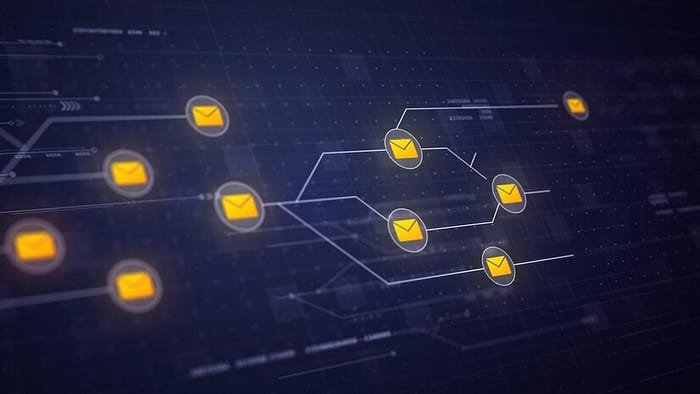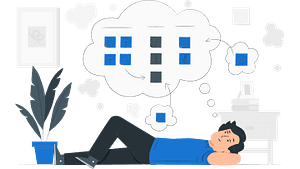At times, in order to manage, maintain, and keep all your business apps updated to reduce data redundancy, enterprises look for application integration. Enterprise Integration Architecture (EIA) helps companies integrate multiple business applications that were not designed to function together in the first place. In simpler words, EIA is a typical organization implementing software architecture that incorporates numerous IT components.
Evolution Of The Enterprise Integration Architecture

Integration architectures have developed over time to introduce new architectures and technologies. This evolutionary path included point-to-point (P2P) integrations, Enterprise Application Integration (EAI) middleware, and Service-Oriented Architecture (SOA) linkages.
In some ways, integration is about “breaking down silos” and facilitating communication between disparate software programs. Embedding an application in a larger context may necessitate the use of specialized tools, such as application programming interfaces (APIs), designed particularly for this purpose. Cloud-based architectures and other novel choices for integration architectures are gaining popularity.
Engineers assemble workable designs that integrate their numerous components using APIs, middleware, and other resources. When applied to business, this is frequently referred to as enterprise application integration, and it is performed to meet critical business objectives.
Another way to think of integration architecture is as the “skeleton” of an information technology system or, as some professionals refer to it, the “plumbing” of the system. Different integration methods, such as point-to-point and different “topologies” for integration, make a difference in design.
Numerous organizational architectures include integrations enabled by one or more of the patterns above. Modern architectures such as API/microservices and event-driven architectures suit the hybrid cloud aim. By implementing these newer design patterns, enterprises hope to achieve greater maturity and optimum integration architecture. This architecture evolves as cross-platform utility and other development paradigms for new digital operations become available.
Why Is Enterprise Application Integration Important?

The majority of organizations operate daily with various software packages from a variety of providers. These applications may have a variety of purposes, data storage locations, and modes of operation. This might result in data silos, where data is duplicated or is available in one database but not in another. When users manually copy and paste data between programs, data inconsistencies. Additionally, users may be required to consult multiple applications as part of their everyday work.
EAI provides a framework for these different apps to share data and workflows to decrease manual procedures and errors and better understand their organization’s data. This becomes increasingly critical as an organization expands and technology improves.
Historically, all business processes were manual and conducted on paper. As computers automated tasks for users, the day-to-day responsibilities of information workers quickly shifted to data preparation and transport. This requirement for rapid data exchange between applications will only grow in importance as more organizations implement microservices, software as a service (SaaS), and platform as a service (PaaS) solutions. EAI can aid in the elimination of manual steps and the reduction of user error.
Goals Of Enterprise Application Integration
Database integration is a frequent and straightforward EAI aim. Eliminating data duplication and establishing consistency across apps can help decrease errors and liabilities. EAI can be accomplished by configuring many apps to share a database or using synchronization technologies to keep multiple databases current with changes. This is feasible with the right data warehouse design. These may be more simply integrated into extensive data systems for improved business intelligence (BI).
Workflow integration enables disparate systems to boost productivity by simplifying everyday tasks. Onboarding a new employee, for example, may need human services to adjust payroll, personnel records, desk assignments on a floor plan, door access restrictions, and IT resources. These different jobs can be completed with EAI in a single process rather than in separate apps.
Instead of presenting operators with several interfaces from disparate software packages, interface integration enables organizations to display a single consistent user interface and user experience (UI and UX). This is the most challenging type of EAI to implement, as minor changes to the underlying program might result in work being redesigned.
Types Of Enterprise Application Integration

While implementing an EAI depends on the underlying project’s tools and objectives, some common design patterns have evolved.
Integration on a point-to-point basis. This is the most basic type of Enterprise Integration Architecture. It extracts data from one source, maybe reformats it, and then passes it on to the next program. These are frequently straightforward to build for fast workflows involving a few tools. However, as more apps and connections are introduced, they can quickly become vast and complex to maintain and slow as a backlog or delay in one system impacts others in the line.
Integration of hubs and spokes. This approach uses central software to manage the data and processes that flow across the participation applications. The program can handle data reformatting and keep workflows streaming in application slowness. As a result, hub-and-spoke is more dependable and speedier than point-to-point but requires additional development time and effort to set up and maintain.
Integration of buses. This is a development of the EAI hub-and-spoke design. Additionally, it is referred to as an enterprise service bus (ESB). In a typical organization bus design, all participating applications communicate and exchange data or operations using a common set of standards. This enables rapid integration but necessitates effort during the planning and product selection phases.
Integration of middleware. This requires the usage of an intermediary program to connect the end-user to the underlying application. Middleware enables interface integration based on a hub-and-spoke or bus architecture.
Microservices. These are modest, specialized instruments that aid in implementing EAI activities. These can be serverless operations or specialized apps that facilitate or expedite the integration of programs. Microservices are frequently amenable to offloading as cloud workloads.
Key Takeaway
After establishing a modern strategy for integration architecture, it is equally significant to develop a hybrid integration platform aligned with the goal architecture. Enterprises can choose from various hybrid integration platform options on the market. HazenTech offers an integration solution that accelerates and improves the quality of your apps and integrations by leveraging automation, training AI models on operational data, and providing a variety of integration methods.
Additionally, HazenTech offers end-to-end enterprise integration architecture to assist organizations in modernizing their integration architectures for hybrid cloud environments. Visit HazenTech Cloud Integration services to discover more about how we can help you update your integrations through automation and artificial intelligence.










